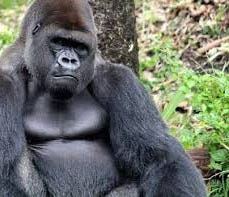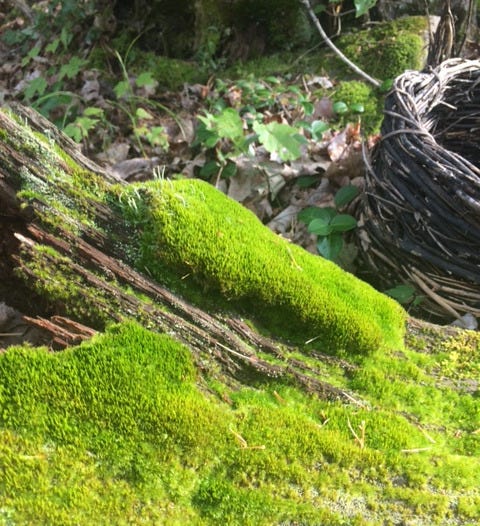Koko, the gorilla, became famous for her gift with language and her remarkable friendship with the late actor Robin Williams. She communicated in sign language to an extraordinary degree, and when a trainer once signed the question, “Where do animals go when they die?” Koko replied, to a comfortable hole in the ground. So may it be.
Last night, a room full of people gathered to listen about the virtues of green burial. Our local green burial advocacy group had been working for eight years to make this option available locally. (Special thanks to Sue and David Lyon.) Now a site has been approved, a cemeterian appointed, and plots are for sale! It’s hard to describe the feeling of having this dream come to fruition. And even harder to explain the elation at having bought plots for our family.
It was some time ago that I learned that our bodies can nourish the earth, much like good compost. As I wrote in The Call to the Far Shore, “…I’m not against cremation, but I have found a longing to be buried, submerged into the belly of the Earth Herself, and to give back my body to the root of all things, in doing so becoming a part of all things.” Well, I now have a picture of where my body will gradually decompose and where my bones will lie: a meadow beside an existing old country cemetery. With no individual gravestones, no toxic embalming or inorganic casket materials, the meadow will remain as natural aspossible, with minimal upkeep. Burial is done at three feet, not six, in order to take advantage of the microorganisms that lie nearer the surface, for they aid in creating a shorter decomposition time.
I didn’t know that not having a specific plan for where I’ll leave my mortal remains when I die had consequences for me. How many of us think about this these days? Either we presume there is a cemetery available, one in line with our values, or we leave it to our loved ones to figure out what to do with our cremated remains.
There is no way around not dealing with our inevitable death, and what remains. Someone will have to make decisions if we do not.
We probably know a lot of people who have their mum or their grandpa in an urn in the basement. I know we did. It felt okay at first when we didn’t know where my husband’s father’s remains would go, and he took up residency on our mantle. But after a while, he made it down to our storeroom in the basement. And there he stayed, for years. It took a moment of great resolve to find an honourable place and way for him to finally go into the earth. He needed to. When Michael took his urn to land near his birth place, and with prayers and ceremony released his ashes, a sigh was felt. A completion that was overdue.
There was another reason for elation the other night as we bought our plots. Many of our friends were doing so as well. There was a degree of awe, stupendousness, and even hilarity when we realized we’ll all be buried right next to each other. That we would be neighbours, forever. We are already planning picnics.
Not that long ago, it would have been usual to have a picture of our “final resting place.” Visiting family and friends at the local cemetery was an integral part of life. For our great-grandparents, knowing exactly where they would be buried wasn’t a mystery. Now that it’s not a mystery for me any longer, I have a surprising sense of levity. An empty hole in me, that I didn’t know I had, has been filled, another hand extended to my irrevocably faithful companion, death. And that’s okay. Because like Koko, there’s great solace in knowing where this body is going—to a comfortable hole in the ground.
More on these themes are found in Nancy’s book, The Call to the Far Shore: Carrying Our Loved Ones through Dying, Death, and Beyond, now available through your local bookstore, Amazon, and most major booksellers.
https://www.amazon.ca/Call-Far-Shore-Carrying-through/dp/B0D9TMVNL9
https://www.simonandschuster.com/books/The-Call-to-the-Far-Shore/Nancy-MacMillan/9798888501092
Reviews:
“The Call to the Far Shore is, first and foremost, a really good book. It is well written, deeply personal, level-headed, thoughtful, and fueled by compelling stories—the author’s own and those of others. Nancy MacMillan proves to be a most knowledgeable and compassionate guide on the journey we all eventually will make to the other side.” —Lawrence Scanlan, author of A Year of Living Generously and coauthor of The Man Who Listens to Horses
Thanks for reading my substack. Subscribe for free below if you haven’t already.







Your delight about the opening of the green burial site reminded me of an experience I had several years ago...
I was with some friends on a patch of land near the edge of the Ganaraska River. It was a beautiful spring day and we had agreed to intuitively commune with whatever called out us in the landscape... My attention was drawn to several rotting fish on the riverbank. Reluctantly, I sat down beside the them and listened for their message.
"We give our bodies to the land. At some point, it is all we have to give and we give in, having gathered memories or water, silt, river plants, stones and air. There comes a time to give this back to the earth, a fish-full life.
The slow rotting of flesh a long, surrendered letting go. No shame, just meeting and mingling as the memories are slowly, silently returned to the land. A fish-blessed land sings differently than one starved of the sea. Our bodies carried travelling songs that are passed on through our bones, back to the spaces in the land that welcome our bone-story-songs.
When you die, remember this — your decaying body is a gift. Do not shy away from its healthy stages of putrefaction. Your storied memory will release slowly into the land, each phase of decay a gift to where you are planted. Every memory freed is a blessing to the land.
Even in death, there is more your body can do, and then the decaying process is made holy, not repugnant, the earth folds into receive the stories, songs, and living memories."